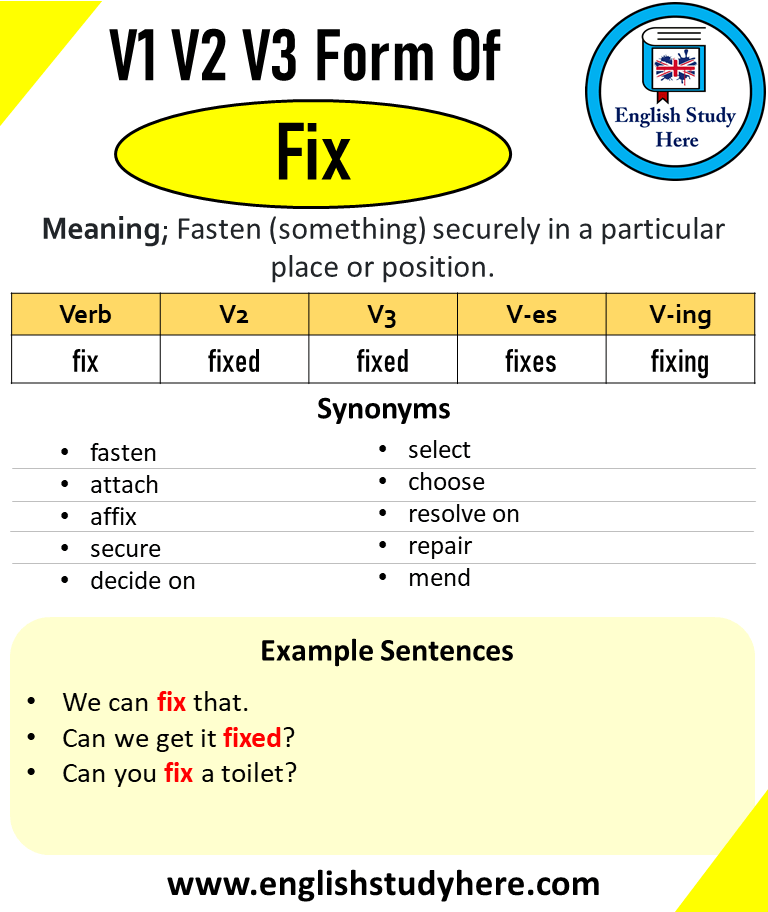Fix Past And Past Participle Form V1 V2 V3 V4 V5 Form of Fix
Are you often puzzled by the different forms of the verb “fix”? You’re not alone.
Many English learners and even native speakers find themselves tangled up in the various tenses and forms of verbs. Understanding the past and past participle forms of “fix”—or any verb, for that matter—is crucial for effective communication. Imagine being able to write or speak confidently, knowing your grammar is spot-on.
We’ll break down the V1, V2, V3, V4, and V5 forms of “fix” in a way that’s simple and easy to grasp. By the end, you’ll have a clear understanding that will enhance your writing and speaking skills. Ready to fix those grammar woes once and for all? Let’s dive in.

Credit: englishstudyhere.com
Fix Forms Explained
The verb “fix” changes form based on tense. The base form is fix. This is called V1. In the past tense, it becomes fixed, which is V2. The past participle is also fixed. That’s V3. For present participle, use fixing. This is V4. Simple, right?
To use “fix” in different contexts, remember these forms. It helps in writing sentences correctly. Let’s look at a table to make it clear.
| Form | Example |
|---|---|
| V1 | Fix |
| V2 | Fixed |
| V3 | Fixed |
| V4 | Fixing |
| V5 | Fixes |

Credit: in.pinterest.com
Usage In Sentences
Fixis a simple word. It means to repair something. You can fix toys. You can fix cars. People fix problems every day. Fixing things is helpful.
Yesterday, I fixedmy bike. Last week, he fixed his computer. She fixed her broken chair. We fixed the window last night. They fixed the door last month.
He has fixedthe car. She has fixed her phone. They have fixed the fence. We have fixed our shoes. You have fixed your glasses.
I am fixingmy toy now. She is fixing her hair. He is fixing dinner. We are fixing the TV. They are fixing the lamp.
Tomorrow, I will fixmy bike. Next week, he will fix his watch. She will fix her dress soon. We will fix the roof later. They will fix the sink later.
Common Mistakes
Many people use the word “fix” incorrectly. Fix is a regular verb. Its simple past form is fixed. The past participle form is also fixed.
Sometimes, people get confused. They use “fix” instead of “fixed”. This mistake is common. Remember, “fix” is present tense. Use “fixed” for past actions.
Let’s look at the V1 V2 V3 V4 V5 forms of “fix”:
| Form | Example |
|---|---|
| V1 | fix |
| V2 | fixed |
| V3 | fixed |
| V4 | fixing |
| V5 | fixes |
Practice makes perfect. Use the right form. It will help you write better.

Credit: englishgrammarhere.com
Conclusion
Mastering the forms of “fix” is essential for clear communication. Understanding V1, V2, V3, V4, and V5 forms helps in accurate language use. The past and past participle forms, “fixed,” are commonly used in everyday conversation. Practice these forms to improve your English skills.
Consistent use makes language learning easier. Remember, regular practice is key to progress. As you use these forms, your confidence will grow. Keep learning and applying your knowledge in real-life situations. Language mastery is a journey, not a destination. Keep fixing your way to better English!






